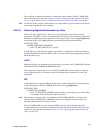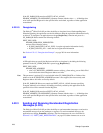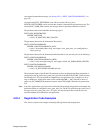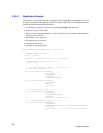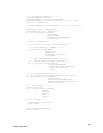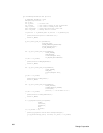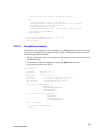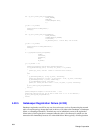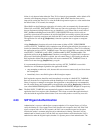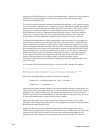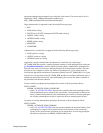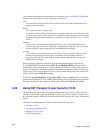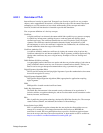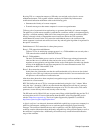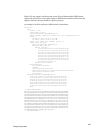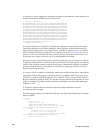285
Dialogic Corporation
failure is only detected when either the Time To Live interval (programmable, with a default of 20
seconds) or the Response timeout (2 seconds) expires. RAS failure detection times can be
improved by setting the Time To Live value in the RAS registration request to a value smaller than
the default value, to 10 seconds, for example.
When RAS loses the Gatekeeper registration, all existing calls are automatically disconnected by
Global Call, and GCEV_DISCONNECTED events are sent to the application. Calls in progress
that are disconnected during RAS recovery are identified by a call control library result value of
IPEC_RASReasonNotRegistered in the GCEV_DISCONNECTED event. All new calls are
gracefully rejected and will continue to be rejected until RAS successfully registers with another
Gatekeeper or explicitly unregisters and allows the H.323 stack to restart in manual RAS mode.
The application can use the gc_ReqService( ) function to perform the re-register or unregister
operation.
All gc_ReqService( ) function calls result in the return of either a GCEV_SERVICERESP
(success) or GCEV_TASKFAIL (fail) completion event. If RAS registration fails (for example, as a
result of an immediate socket bind failure or failure notification following a Time To Live timeout),
the application receives a GCEV_TASKFAIL event. The range of applicable cause values for RAS-
related GCEV_TASKFAIL events is IPEC_RASReasonMin to IPEC_RASReasonMax. The
application must use the gc_ReqService( ) function to reconfigure or register RAS in response to
that event. If the RAS registration is rejected, the call control library is still cleaning up after the
RAS registration failure and the application will receive another GCEV_TASKFAIL event, in
which case it must issue gc_ReqService( ) yet again.
It is recommended (but not required) that after receiving a GCEV_TASKFAIL event which
identifies loss of Gatekeeper registration, the application should:
• stop attempting to make new calls, because this uses resources unnecessarily and slows down
the cleanup time
• immediately issue a new RAS register or RAS unregister request
RAS registration requests should be made immediately on receipt of a RAS GCEV_TASKFAIL.
Recovery from the loss of registration with the Gatekeeper is not completed until the call control
library re-registers or attempts to unregister. Re-registration or unregistration is not attempted by
the call control library until commanded by the application using the gc_ReqService( ) function to
issue a RAS REGISTER REQUEST or a RAS UNREGISTER SERVICE REQUEST respectively.
Note: The RAS GCEV_TASKFAIL event automatically repeats at intervals of 30 seconds if the
application does not re-register with a Gatekeeper. This is done to remind the application that it
must deal with the registration failure before it can successfully make or receive any new calls.
4.23 SIP Digest Authentication
Authentication is a process which allows a remote endpoint (a User Agent Server, or UAS) to
verify the identity of a User Agent Client (UAC) that has sent a request to the UAS. If the UAS
rejects a request with a 401 or 407 response, the UAC can re-send the request in a form that
includes the sender’s username and password to authenticate its identity. Once the UAC has
authenticated its identity to the UAS, the UAS may require further verification that the UAC is
authorized to make the original request, but that is a separate process from authentication. The



